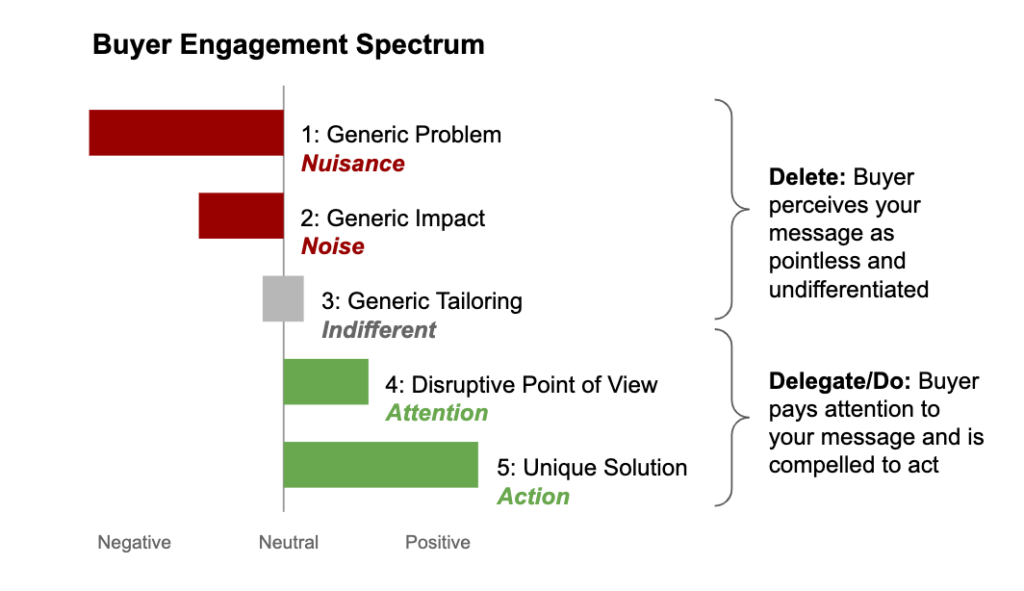Delete, delegate or do. It’s a split second decision. Your message (e.g. ad, email, voicemail, in-person meeting) has a simple goal to drive the highest level of buyer engagement in the shortest amount of time.
Every interaction you have with a current or prospective buyer matters. You are judged the moment you engage. Judged not for what you do or what you sell, but to determine if the buyer should spend his/her most valuable resource with you — their time.
Delegate or do is the outcome every marketer and seller seeks. Do request an introductory meeting. Delegate a team member to follow-up. That’s early in buyer engagement. In the middle of the sales cycle, do commit to the demo. Delegate additional team members to review competitive offerings. Later in the process, do discuss pricing and negotiation terms. Delegate legal or sourcing to review the contract terms.
But what happens instead is all too common….Delete. How you engage determines if you get the buyer’s attention/action, or get dismissed as noise or a nuisance. These are the anchors of the buyer engagement spectrum.
While we pay close attention to movement in the sales cycle (e.g. is this deal progressing?) we fail to fully appreciate the buyer engagement spectrum and its implications. Today’s buyer is radically different from what we knew even three months ago. Yes, they are digitally savvy, self-directed (at work and working from home), and they are in control. See Forrester’s Welcome to the B2B Marketing Renaissance report for more on just how much of the decision process is made without you.
This means an integrated approach between your digital channels largely owned by marketing and your sales teams is more important than ever. Furthermore, in this tough economic environment, your customers will be pressured to reduce costs — placing your upcoming renewals at risk. “Run the playbook” echoes across virtual meetings with marketing, sales, and customer success teams around the globe. But as many organizations have attempted to execute their playbooks during these difficult times, large gaps have emerged.
Recognizing where you are on the “Buyer Engagement Spectrum” is the first step in analyzing your playbook. See Diagram 1. As part of this question, be honest about where your message is landing. Are you a nuisance (delete) or a partner (delegate/do)? There is no better time than now to take stock and examine if your company is achieving the highest level of buyer engagement to move your business forward.
Diagram 1: Buyer Engagement Spectrum

1: Generic Problem
Imagine the number of messages and conversations your buyer is receiving that starts with “Whether you already work from home or this is your first time, we’d like to support your business as you adapt to new challenges.” While these messages are empathetic and seemingly strike the appropriate tone, they sound like every other message the buyer is receiving at this time. This generic problem approach (without further support) is a guaranteed way for your message to not only be ignored, but creates a negative association which can put future interactions at risk. Delete.
2: Generic Impact
Similar to the generic problem, some messages add an impact statement such as “working with our cost-effective and profitable email marketing services can assist you to send successful email campaigns to your customers.” This generic outcome comes across as sounding like every other vendor with little consideration for the buyer’s business objectives. Delete.
3: Generic Tailoring
Here’s the problem with generic tailoring. You have placed effort into showing you know something about their business, but so has every other credible vendor. This approach is especially dangerous because it creates a false sense of hope within your teams (because you have put some energy into “tailoring” the message). You’ve given the buyer something to think about, but not enough to change the status quo. Sellers waste their most precious resource of time in these murky engagements. These sales cycles never seem to get the proper sponsorship. There is little priority from the buyer. The forecast keeps slipping. Sound familiar? If you are lucky, a price war ensues because you have not brought anything unique to the table. More often than not, they stay with the status quo or whatever choice is easiest. Delete.
4: Disruptive Point of View
The word “insight” is thrown around as the secret sauce to success. But when asked, marketers and sales professionals are constantly struggling to define and develop insights that lead to differentiation. Instead of insights, focus on creating a point of view (PoV) that sheds light on the biggest set of challenges/friction points in your buyer’s industry that lead to your solution.
Too often, the “Generic Tailoring” approach is confused with a PoV. Your buyer will let you know that your PoV resonates by rewarding you with high priority and urgency. Delegate or Do.
5: Unique Solution
Frame your proof (e.g. case studies and demos) specifically to solve the challenges described in your PoV. Presenting your PoV, followed by your unique position, not only gives you high priority and urgency in the buyer’s mind, but you find yourself in a unique position. Your solution is viewed as the most credible and viable option for the challenges it’s being purchased to solve. Delegate or Do.
For more detail on the five messaging approaches and their likely impact on buyer engagement, see Diagram 2. More importantly, where do you fall? Nuisance or Partner?
Diagram 2: Messaging Across the Buyer Engagement Spectrum

Taking an honest candid look at where you are showing up in the Buyer Engagement Spectrum is not easy. However, it is the only way to assess if your playbook is effective. To help simplify this process, we have developed a Buyer Perception Scorecard. We will share this scorecard, how organizations perceive themselves and how buyers actually perceive the same organizations in our next article.
This is guest post by John Hsieh, Janet Gerhard and Michael Hvisdos. They engage organizations in optimizing their customer acquisition, retention, and growth motions. Reach out for a fresh perspective on how your sales, marketing, and customer success teams can create a unified focus that pushes your team to reach their maximum effectiveness levels. They can be contacted at info@inquizo.com
